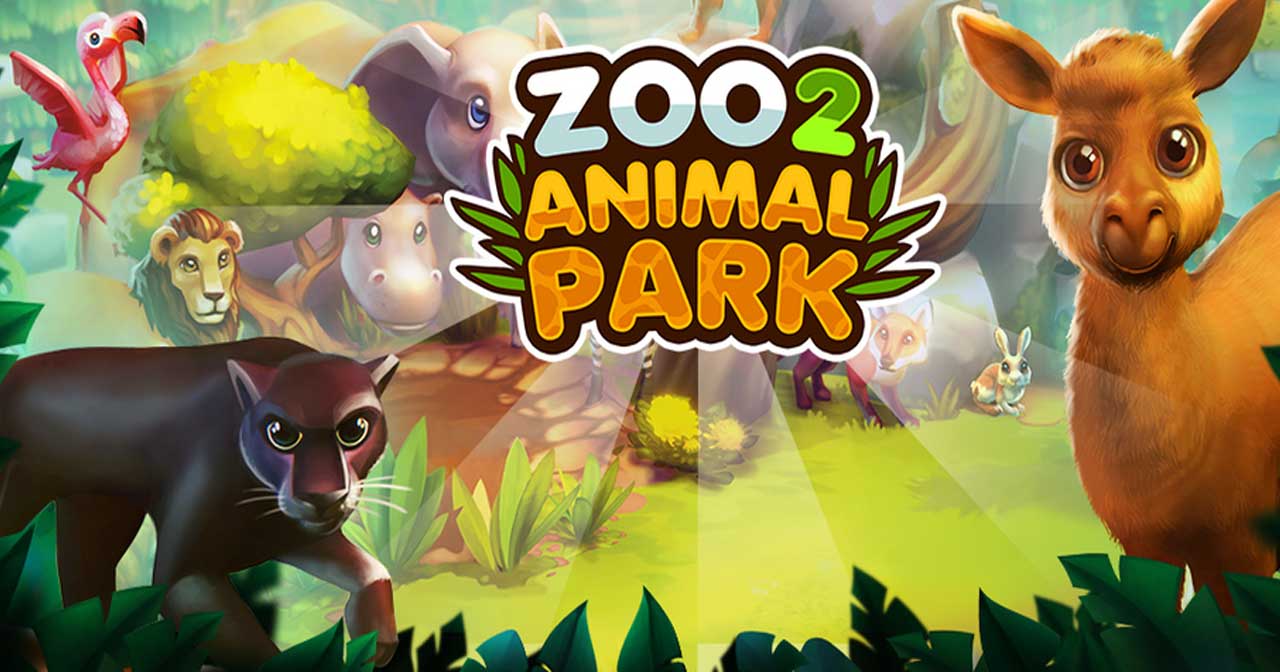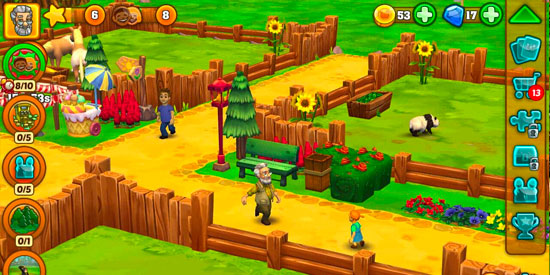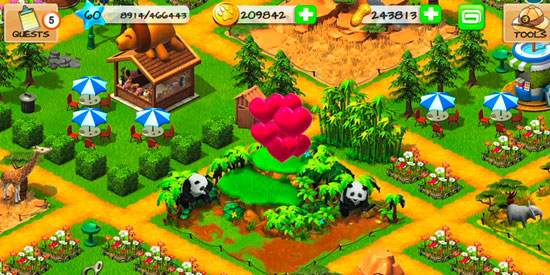
Zoo2: Animal Park
| Genre: Simulation |
| Rating: |
Welcome to your new job! In this building simulation you hold the post of Zoo Director. Save your Zoo from destruction. Create walkways. Build different animals, and there are feed, water and playground equipment. Build the infrastructure of your zoo, set up a breeding station and take care of offspring, which will make your visitors enthusiastic. The more men, women and children visit your Zoo, the more Zoo Dollar you earn.
Cute critters. Colorful chaos. And a zoo that actually needs you.
Zoo 2: Animal Park isn’t just a game—it’s a little wild world full of charm, surprises, and the occasional escaped goat.


Welcome to the Wild Side
You ever start a game just to “check it out” and suddenly it's two hours later and you’re arguing with yourself about whether to add a lemur habitat or a peacock enclosure first? Yeah. That’s Zoo 2: Animal Park in a nutshell. One minute you're dragging fences into place, the next you’re totally invested in whether your jaguar prefers trees or rocks.
There’s something weirdly comforting about it all—like stepping into a pop-up book where the animals move, the trees sway, and time sort of slows down just enough to let you breathe. Maybe it’s the art style. Maybe it’s the adorable animations. Or maybe we just really need wholesome games right now. Either way, it works.
So What Is Zoo 2: Animal Park, Really?
Alright, let’s break it down. Zoo 2 is a simulation and zoo management game developed by Upjers, the same studio behind games like My Free Farm and My Little Farmies. If you’ve ever played a tycoon-style game—think RollerCoaster Tycoon but replace the screaming kids with curious red pandas—you’ve already got the idea.
But don’t let the colorful graphics fool you into thinking it’s just for kids. Sure, your niece might love decorating a flamingo pond, but there’s a surprising amount of depth packed in here. You’re managing habitats, coordinating feedings, expanding enclosures, juggling visitor satisfaction, and occasionally dealing with oddly judgmental zoo staff (not kidding—they will sigh if you’re slacking).
At its heart, it’s a balancing act. But a charming one.
Zoo Management, But Make It Cozy
So here’s the thing—this isn’t some high-pressure simulation where you're punished for blinking. Zoo 2 keeps things light. There’s a natural ebb and flow to how the gameplay unfolds. You build enclosures, bring in animals, welcome visitors, and slowly but steadily expand your park. It’s relaxing—but not boring.
You might find yourself saying, “Okay, one more habitat,” only to realize you’ve rearranged your entire south quadrant because the zebras were throwing off your aesthetic. And I mean... we’ve all been there, right?
Sure, there are timers. Certain buildings take time to upgrade, and some animals won’t show up until you’ve hit a milestone or two. But nothing feels punishing. It’s more like the game gently nudging you to take a break, stretch your legs, maybe pet a real dog.
The Real Stars? The Animals, Obviously.
Let’s not pretend we’re here for the fences and fountains. It’s the animals that steal the show.
From the moment your first bunny hops into its pen, you're hooked. The art style is whimsical but not overly cartoony, which strikes a sweet balance between realism and playfulness. You’ll notice the giraffes lazily chewing, the foxes snoozing in the shade, the penguins waddling in that oddly hypnotic way penguins do. It’s delightful.
And you know what? You start caring. Genuinely. When you unlock (wait—add) a new species, there’s a sense of excitement that’s more “new baby at the zoo” and less “checklist item.” You’ll rearrange layouts to make animals happier. You’ll spend way too long choosing decorations because “this llama deserves a prettier view.”
Let’s take a second here: why do games like this hit us so deeply? I think part of it is the illusion of closeness. In real life, you’d need permits and years of training to get near a tiger. But in Zoo 2, you feed one with a tap. It’s not just interaction—it’s connection. Simulated, sure, but no less emotionally effective.
Events, Missions, and Why You’re Always Coming Back
Here’s something subtle the game does really well: it always gives you something to look forward to.
Whether it’s a seasonal event (think: winter wonderland themes with reindeer and snow-covered paths) or a mission to rescue a rare animal, there's a steady stream of short-term goals and longer-term challenges. And they aren’t overwhelming. They're just... there. Waiting. Like a friend reminding you that yes, your koalas could use a eucalyptus upgrade.
There’s also that little hit of joy when you complete a task—earn a badge, expand a habitat, or simply see your zoo bustling with visitors. It’s game design psychology 101, but it works.
Micro Interactions = Macro Joy
Zoom in on any area of your zoo and you’ll see it—tiny details that add unexpected charm. A child tossing popcorn (maybe too close to the monkeys), an alpaca nuzzling its buddy, a zookeeper strolling with a clipboard that looks way too official for this kind of game.
These little touches matter.
They breathe life into what could easily become a static simulation. And more than that, they provide a sort of background joy. You don’t have to micromanage every second, but when you do look closely, the world feels alive.
There’s a quiet satisfaction in cleaning an enclosure or feeding your animals—kind of like tidying up a space in real life and feeling your brain go, “Ahhh, much better.”
Visuals That Feel Like Warm Fuzzies
The graphics? Think storybook vibes meet low-key animation. It’s bright, but not blinding. Stylized, but not overdone. Honestly, it’s the kind of look that could belong in a children's illustrated encyclopedia—and that’s not a knock. It’s a style choice that makes everything feel approachable.
Menus are clear, icons are intuitive, and the whole thing runs smoothly without demanding high-end devices. It doesn’t scream for attention—it earns it quietly.
There’s also something oddly timeless about the look. You could show this to your younger cousin or your grandma and both would probably be into it. Not many games hit that intergenerational sweet spot.
Multiplatform Fun Without Fuss
Let me tell you, being able to pick up where you left off—whether you're on your lunch break at work (no judgment) or lounging with your tablet on the couch—is a massive plus.
Zoo 2: Animal Park plays well across devices. Mobile and browser versions are well-optimized, and syncing your progress feels seamless. It’s the kind of game you can dip into for five minutes or get lost in for an hour without feeling tethered to one device.
It fits into life the way casual games should: flexible, forgiving, and always just a tap away.
But Hey, It’s Not Perfect
Okay, time for some honesty.
There are a few speed bumps along the way. Some buildings and upgrades take a while to finish, and if you’re the impatient type, you might find yourself checking the clock a little too often. Repetition can also sneak in after long play sessions—there’s only so many times you can collect trash before your inner voice starts asking if this is what adulthood really looks like.
Menus, while generally clean, can get a bit cluttered once your zoo really takes off. You may catch yourself muttering, “Wait—where the heck is the snack bar upgrade button again?”
But you know what? These aren’t deal-breakers. They’re just gentle reminders that no simulation is flawless. And somehow, it adds to the game’s humanity. Like, “Oh look, even digital zoos have growing pains.”
Is It Worth Your Time?
Let’s ask the real question: who is this game for?
-
If you love animals, absolutely.
-
If you’re a fan of cozy games like Animal Crossing or Stardew Valley, but want something more structured, yes.
-
If you just want something low-stakes to tinker with between Zoom calls or while waiting for your coffee to brew—this’ll hit the spot.
But if you’re hunting for a fast-paced, high-drama, hyper-strategic sim with intense competition and big boss battles? Yeah... probably not for you.
Zoo 2: Animal Park is about rhythm, not rush. It’s a warm cup of tea, not an energy drink. It’s a game that smiles at you instead of shouting. And honestly, in a world that often feels loud and messy, that’s kind of the point.
Final Thought: A Little Wild, A Lot of Heart
There’s something wonderfully simple—and sneakily meaningful—about creating a space for animals, watching them thrive, and seeing your little zoo grow from a patch of grass into a thriving sanctuary.
Zoo 2: Animal Park doesn’t demand much. But it gives plenty. Whimsy. Warmth. And maybe, just maybe, a reason to keep coming back—not because you have to, but because you want to.
And hey, when was the last time a game made you smile because your meerkat finally had a buddy to nap with?
Exactly.